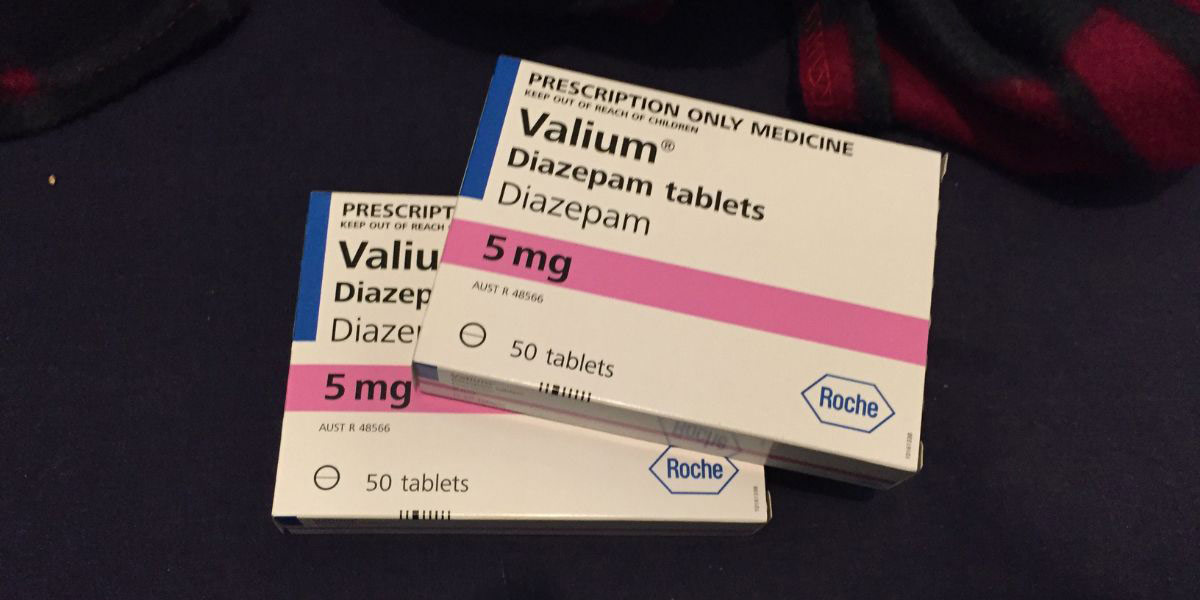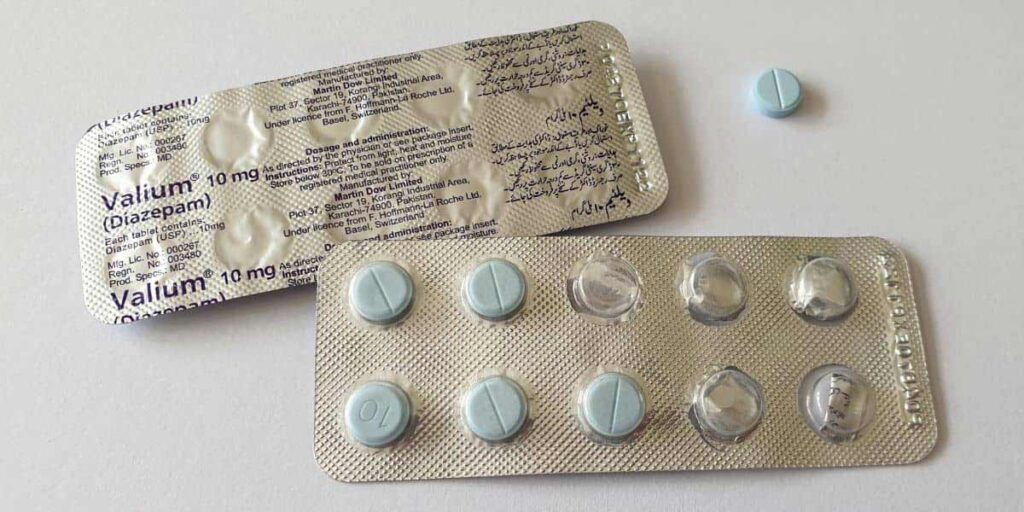Valium (Diazepam) Side Effects and Addiction


Diazepam, also called Valium, calms the brain and nerves. It is effective for managing anxiety and panic attacks when used regularly.
Doctors typically administer Valium, a type of benzodiazepine, in tablet form. It carries a significant risk of addiction and potential for misuse.
Using diazepam for more than four to six weeks increases the risk of addiction. Many people may need professional help to stop using it safely.
What Is Valium?
Diazepam, also known as Valium, is a medication used to treat anxiety, panic attacks, and alcohol withdrawal symptoms. It is also used for insomnia, muscle spasms, and sleep apnea.
Valium is a long-lasting benzodiazepine containing diazepam stored in fat tissues with a slow metabolic rate. Doctors use it to treat conditions such as anxiety or muscle spasms. Patients may need fewer doses over time if they follow their doctor’s instructions and medication guide.
Valium generally requires regular administration to be effective for most people. However, misuse of Valium or its combination with other medications can rapidly lead to addiction and drug abuse.
What Is Valium Used For?
Valium was initially used in the 1960s to treat anxiety. Now, it is used for various other conditions as well. This is because more is known about diazepam.
Valium affects the brain and central nervous system. It causes a calming effect on the body’s nerve activities. This helps with receiving and sending information throughout the body. This mechanism makes Valium particularly effective for treating conditions such as:
- Sudden bouts of fear
- Muscle contractions
- Anxiety
- Breathing interruptions during sleep
- Calming during medical operations
- Convulsions
What Does Valium Look Like?
Valium pills, sold under the brand name, vary in color depending on their dosage strength.
Valium pills are available in three different doses, each with distinct characteristics:
- 2mg: A circular white tablet with a V-shaped notch in the middle. One side is stamped with 2 Valium, while the opposite side is marked with ROCHE twice
- 5mg: A round, yellow tablet with a V-shaped indentation at its center. One side is stamped with 5 and Valium, and the other face carries the imprint ROCHE twice
- 10mg: A light blue, round pill imprinted with a V-shaped stamp in the center; on one side, 10 Valium and Roche twice on the other side.

Copyright: The Drug Users Bible
Credit: Dominic Milton Trott
CC BY 2.0
Valium Side Effects
Like many prescription medications, Valium can cause side effects. Doctors who prescribe diazepam typically believe that the medication’s benefits surpass the potential side effects. This assessment is crucial in determining whether diazepam is an appropriate treatment option, particularly for patients dealing with conditions that require its therapeutic effects.
Even when Valium is used as prescribed, side effects can still occur. Still, these adverse reactions are typically mild and usually fade away once the drug is eliminated from the body.
Valium has common side effects, including:
- Parched mouth
- Muscular feebleness
- Lightheadedness
- Sleepiness
- Muscular convulsions
- Tiredness
- Sickness
- Migraine
- Irregular bowel movements
Regardless of the dose of diazepam, you should not drive a car or operate machinery after taking the medication. It also needs to be kept out of reach of children.
Before starting Valium, call your doctor for medical advice about side effects. They can provide information on what to anticipate, what symptoms to watch for, and when it is necessary to seek help.
Long-Term Effects of Valium
People who are dependent on Valium for the long term or those who misuse it may encounter more severe side effects.
Research indicates that older people are prone to the prolonged impacts of diazepam. Changes in metabolism and organ performance accompanying aging may contribute to this vulnerability, potentially leading to increased sensitivity to the drug’s effects.
Some of the long-term side effects associated with Valium use include:
- Forgetfulness
- Despondency
- Delusions
- Bewilderment
- Delayed or mumbled speech
- Respiratory distress or breathing problems
- Double or unclear vision
- Sleeplessness
- Suicidal thoughts
- Reduced libido
- Lack of bladder and bowel control
- Slow pulse rate or bradycardia
- Fainting or sudden blood pressure drop, also known as syncope
- Hepatic disease
- Increased eye pressure leading to potential blindness, also known as narrow-angle glaucoma
- Chronic muscle weakness and tiredness due to myasthenia gravis
- Impaired balance and coordination
- Liver disease
If the side effects seem very dangerous, getting emergency help immediately is important.
Valium Interactions
Valium poses a significant risk of hazardous interactions with other prescription drugs, alcohol, over-the-counter medications, herbal remedies, and illicit substances.
Valium is a strong medication. Mixing it with other drugs or alcohol can be dangerous and sometimes life-threatening.
Diazepam possesses sedative properties, which significantly increase the risk of accidental overdose when combined with other depressants.
Here is a comprehensive list of some of the most common medications that heighten the risk of drug interactions with Valium:
- Pain relievers containing opioids
- Cough remedies available on prescription and over-the-counter
- Medications for muscle relaxation
- Sleep aids available on prescription and over-the-counter
- Other medications for anxiety
- Medications for motion sickness
- Anti-convulsion medications
- Medications for depression
It’s essential not to combine drugs unless explicitly instructed by a physician. Always notify your doctor or pharmacist about any other medications or supplements you’re currently taking.
Dosages of Valium
It’s essential not to combine drugs unless explicitly instructed by a physician. Always notify your doctor or pharmacist about any other supplements or medications you use. Here are some common dosages for oral Valium (diazepam) tablets tailored to the condition being treated:
- Management of alcohol withdrawal symptoms: Consume 10mg three to four times a day, transition to 5mg if required
- Managing panic and anxiety disorders: 10mg two to four times daily based on the severity
- For Managing muscle spasms: 2mg to 10mg, three to four times daily
- For Managing seizure disorders: 2mg to 10mg, two to four times daily
- Medical sedation before surgery: 10mg, once daily
- Older adults with degenerative disease symptoms: 2mg to 2.5mg once or twice daily, with potential increases under medical supervision
Diazepam dosages vary for each individual and condition, so consult your doctor and adhere strictly to their instructions. If your doctor adjusts your dosage, follow their guidelines carefully to prevent any negative side effects.
Additionally, you should consult your doctor before suddenly stopping diazepam to prevent withdrawal symptoms. Most doctors suggest gradually reducing your dosage over time, a process known as tapering.
How Long Does Valium Last?
Valium starts working in 15 minutes to 1 hour when taken by mouth and lasts for 4 to 6 hours.
Valium is a type of diazepam that works quickly and lasts a long time. It is processed differently by each person due to different physical factors.

How Long Does Valium Stay in Your System?
Valium stays in your body for a period of seven to ten days. Even after its effects have subsided, it remains present in the body.
The time it takes for the body to eliminate diazepam varies from person to person. Their physical characteristics and overall health influence this.
Valium can accumulate in your body if you take it regularly. This can cause it to stay in your system longer. Accumulation of Valium can slow down the process of it leaving your body completely.
Valium Addiction
The National Institutes of Health (NIH) says diazepam is very addictive and easy to abuse because it works quickly. This makes it more likely for people to become dependent on it and misuse it.
There’s a prevalent misunderstanding that drugs prescribed by physicians can’t result in addiction. However, this is incorrect.
Even if you take Valium as prescribed, you can still develop tolerance over time. This means that the same dose may become less effective. A higher dose may be needed to achieve the desired effects in such cases.
Needing more of something and not being able to function without it are signs of developing a dependence. This dependence can lead to a substance use disorder. This can lead to a substance use disorder.
If you stop taking Valium without medical supervision, you may have withdrawal symptoms. This is because you may have become dependent on the drug. Valium withdrawal can be distressing and occasionally hazardous, especially if you have an addiction to several substances.
Stopping Valium can be hard because of physical and mental dependence and fear of withdrawal symptoms. Many struggle to quit without help. However, those who seek help from drug rehabilitation treatment facilities often have a higher chance of successfully quitting.
Benzo Addiction Treatment
Valium withdrawal can be uncomfortable, and many people who attempt it on their own fail. Getting professional help for Valium dependency dramatically minimizes the chances of a relapse.
At White Oak Recovery Center, our team keeps you safe during withdrawal with on-site, supervised medical detox by medical professionals. We then smoothly transition you into our serene residential treatment facility.
Our experts will help you create a personalized treatment plan. The plan will use proven methods like dual diagnosis, therapy, and support groups. These methods will address both the addiction and its underlying causes.
At WORC, our programs help you focus on healing and learn skills for long-term recovery, health, and happiness.
We are on hand to respond to any inquiries you might have and can discreetly confirm your insurance for you.
Reach out to speak with one of our caring and thoughtful treatment specialists today to begin your journey toward a promising future.

Am I covered for addiction treatment?
Your insurance may cover treatment. Call now for an entirely free and confidential assessment. Recovery starts with a phone call.

- “Diazepam.” MedlinePlus: National Library of Medicine, May, 2021.
- Dhaliwal, Jaberpreet S., et al., “Diazepam.” StatPearls: National Library of Medicine, Aug. 2023.
- Leung, Felix W., and Guze, Phyllis A., “Diazepam Withdrawal.” The Western Journal of Medicine, Jan. 1983.
- Calcaterra, Nicholas E., and Barrow, James C., “Classics in Chemical Neuroscience: Diazepam (Valium).” ACS Chemical Neuroscience, Apr. 2014.
- Cheng, Tianze, et al., “Valium Without Dependence? Individual GABA-A Receptors Subtype Contribution Toward Benzodiazepine Addiction, Tolerance, and Therapeutic Effects.” Neuropsychiatric Disease and Treatment, May 2018.
Medical Disclaimer:







